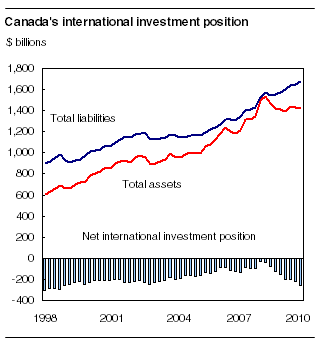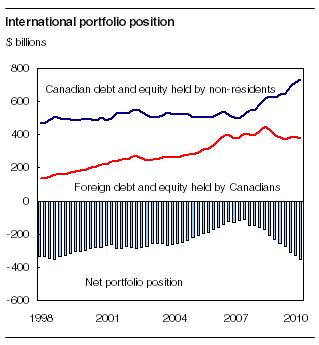Canada's international investment position
Archived Content
Information identified as archived is provided for reference, research or recordkeeping purposes. It is not subject to the Government of Canada Web Standards and has not been altered or updated since it was archived. Please "contact us" to request a format other than those available.
Related subjects
-
[an error occurred while processing this directive]
Canada's net international indebtedness increased by $35.4 billion to $254.3 billion by the end of the fourth quarter. Canada's international liabilities advanced by $29.7 billion, led by continued strong foreign investment in Canadian securities.
Net foreign debt was also affected by a decline in the Canadian dollar value of Canada's international assets, despite increased investment activity abroad in the fourth quarter. The appreciation of the Canadian dollar accounted for a $37.0 billion downward revaluation in international assets. Over the quarter, the Canadian dollar gained 3.5% against the US dollar, 5.3% against the Euro, 4.2% against the British pound, and 0.6% against the Japanese Yen.
For 2010 as a whole, net foreign debt increased by $101.0 billion. This reflected continued strong foreign investment flows into Canada, in line with the ongoing current account deficit, as well as the affect of a stronger Canadian dollar on foreign currency denominated international assets.

Note to readers
The international investment position presents the value and composition of Canada's assets and liabilities to the rest of the world. Canada's net international investment position is the difference between these foreign assets and liabilities. The excess of international liabilities over assets can be referred to as Canada's net foreign debt; the excess of international assets over liabilities can be referred to as Canada's net foreign assets. The valuation of the assets and liabilities in the international investment position are measured at book value, unless otherwise stated. Book value represents the value of assets and liabilities recorded in the books of the enterprise in which the investment is made.
Currency valuation
The value of assets and liabilities denominated in foreign currency are converted to Canadian dollars at the end of each period for which a balance sheet is calculated. Most of Canada's foreign assets are denominated in foreign currencies while less than half of Canada's international liabilities are in foreign currencies. When the Canadian dollar is appreciating in value, the restatement of the value of these assets and liabilities in Canadian dollars lowers the recorded value. The opposite is true when the Canadian dollar is depreciating.
Net direct investment asset position declines further
The appreciation of the Canadian dollar lowered the value of Canadian direct investment abroad, leading to a further $5.4 billion decrease in the net direct investment asset position in the fourth quarter. This occurred even though Canadian direct investment abroad recorded strong outflows as a result of merger and acquisition activity in the quarter. The value of foreign direct investment in Canada was up $9.8 billion in the quarter on stronger investment inflows.
Canadian bonds held by non-residents continue to rise
Non-residents further increased their holdings of Canadian securities in the fourth quarter by $27.3 billion; investment activity was led again by bonds, but with an increased focus on corporate debt. However, the revaluation effect of a rising Canadian dollar on outstanding foreign currency denominated Canadian portfolio debt liabilities moderated the increase in the quarter.
The value of Canadian holdings of foreign securities fell by $7.0 billion in the fourth quarter, reflecting weak investment as well as a downward revaluation of $8.6 billion due to exchange rate fluctuations. This led to a further decline in the overall portfolio balance in the quarter, to reach a net debt position of $350.6 billion.

The change in the net portfolio position has accounted for a large part of the increase in Canada's overall net international indebtedness over the past several quarters, in part a reflection of the global financial crisis and its aftermath. Since the fourth quarter of 2008, non-residents have invested heavily in Canadian securities, especially debt instruments. On the other hand, since the third quarter of 2007, Canadian investors have largely curtailed acquisitions of foreign securities. For 2010, Canadian bonds held by non-residents increased by 15.7% while foreign bonds held by Canadians declined by 3.8%. This was a continuation of the pattern in 2009.
Capital gains on foreign equities held by Canadians partially offset by a stronger Canadian dollar
Canada's net international investment position can also be calculated with tradable securities valued at market prices. By this measure, Canada's net foreign debt increased $35.3 billion to $254.4 billion at the end of the fourth quarter. Gains on foreign and Canadian stock markets were similar during the quarter, but increases for Canadian equity assets abroad were constrained by a $15.1 billion downward exchange rate revaluation. The value of Canadian institutional investors' foreign equities rose by $23.4 billion, compared with an increase of $36.7 billion in non-resident investor holdings of Canadian equity assets.
Available on CANSIM: tables 376-0055 to 376-0057 and 376-0059.
Definitions, data sources and methods: survey numbers, including related surveys, 1534 and 1537.
The fourth quarter 2010 issue of Canada's International Investment Position (67-202-X, free) will soon be available.
For more information, contact Client Services (613-951-1855; infobalance@statcan.gc.ca). To enquire about the methods, concepts or data quality of this release, contact Christian Lajule (613-951-2062) or Komal Bobal (613-951-6645), Balance of Payments Division.
- Date modified:
